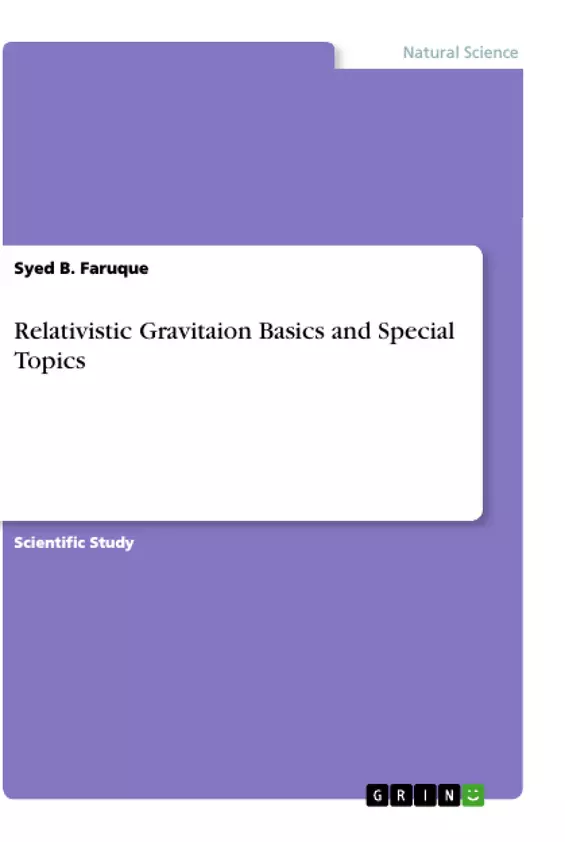Relativistic gravitation is so rich a problem which is beyond any addition. Even then this book will help students of physics to get the essential ingredients of general relativity and find some solved problems. Most of the problems are published matter. The book is short but no doubt very rich in context. Graduate students will be very benefited from the book.
Inhaltsverzeichnis (Table of Contents)
- Chapter 1: Introduction
- Chapter 2: Principle of Equivalence
- Chapter 3: Gravitational Forces
- Chapter 4: Newtonian Limit
- Chapter 5: Curvature Tensor
- Chapter 6: Einstein's Field Equation
- Chapter 7: Derivation of the Orbit Equation in Schwarzschild Field
- Chapter 8: Motion of an Effective Particle in Kerr Field
- Chapter 9: Orbital Shape and Periastron Shift in a Compact Binary
- Chapter 10: Gravitomagnetic Clock Effect
- Chapter 11: Gclock Effect in Spinning Particle
- Chapter 12: Phase Quantization in Relativistic Gravitation
- Chapter 13: Correspondence Between Test- and Effective-Particle Dynamics of Relativistic Gravitational Two-Body Problem
Zielsetzung und Themenschwerpunkte (Objectives and Key Themes)
This book aims to present fundamental concepts and equations of relativistic gravitation, exploring special topics in the field. The author's research and findings in gravitational physics, particularly focusing on orbital mechanics and the relativistic two-body problem, are highlighted.
- Relativistic gravitation and its relation to Newtonian gravity
- The principle of equivalence and its implications
- Gravitational waves and their detection
- The 'effective-one body' and 'constrained Hamiltonian' methods
- Relativistic two-body problem and its applications
Zusammenfassung der Kapitel (Chapter Summaries)
- Chapter 1: Introduction: This chapter provides an overview of relativistic gravitation and its historical context, highlighting the limitations of Newtonian gravity and the role of Einstein's theories in understanding gravity.
- Chapter 2: Principle of Equivalence: This chapter delves into the principle of equivalence, which states that the effects of gravity and acceleration are indistinguishable. It discusses the implications of this principle for understanding gravity and its role in general relativity.
- Chapter 3: Gravitational Forces: This chapter explores the nature of gravitational forces, examining how they arise from the curvature of spacetime. It discusses the role of mass and energy in shaping spacetime and the influence of these forces on the motion of objects.
- Chapter 4: Newtonian Limit: This chapter examines the relationship between relativistic gravitation and Newtonian gravity, demonstrating how the former reduces to the latter in certain limiting cases. It explores the conditions under which Newtonian gravity provides an accurate approximation of relativistic gravitational effects.
- Chapter 5: Curvature Tensor: This chapter introduces the concept of the curvature tensor, which quantifies the curvature of spacetime. It explains how this tensor describes the gravitational field and its effects on the motion of objects.
- Chapter 6: Einstein's Field Equation: This chapter presents Einstein's field equation, which relates the curvature of spacetime to the distribution of mass and energy. It explains how this equation governs the dynamics of gravity and the evolution of the universe.
- Chapter 7: Derivation of the Orbit Equation in Schwarzschild Field: This chapter focuses on the derivation of the orbit equation for a particle moving in a Schwarzschild field, which represents the gravitational field of a spherically symmetric object. It analyzes the properties of these orbits and the implications for the motion of objects near black holes.
- Chapter 8: Motion of an Effective Particle in Kerr Field: This chapter investigates the motion of an effective particle in a Kerr field, which describes the gravitational field of a rotating object. It analyzes the properties of these orbits and their implications for the motion of objects around rotating black holes.
- Chapter 9: Orbital Shape and Periastron Shift in a Compact Binary: This chapter examines the orbital shape and periastron shift in a compact binary system, where two massive objects orbit each other. It analyzes the effects of relativistic gravitational forces on the orbital parameters and their implications for understanding the evolution of these systems.
- Chapter 10: Gravitomagnetic Clock Effect: This chapter discusses the gravitomagnetic clock effect, which arises from the coupling of gravity and the rotation of a massive object. It examines the influence of this effect on the rate of timekeeping and its implications for the understanding of spacetime.
- Chapter 11: Gclock Effect in Spinning Particle: This chapter investigates the Gclock effect in a spinning particle, which describes the influence of the particle's angular momentum on the rate of timekeeping. It analyzes the implications of this effect for the understanding of time and its relationship to gravity.
- Chapter 12: Phase Quantization in Relativistic Gravitation: This chapter explores the phenomenon of phase quantization in relativistic gravitation, examining how the phase of a particle's wave function is affected by the gravitational field. It discusses the implications of this phenomenon for the understanding of quantum gravity and the quantization of spacetime.
- Chapter 13: Correspondence Between Test- and Effective-Particle Dynamics of Relativistic Gravitational Two-Body Problem: This chapter explores the correspondence between the dynamics of test particles and effective particles in the context of the relativistic gravitational two-body problem. It analyzes the relationship between these two types of particles and their implications for the understanding of gravitational interactions.
Schlüsselwörter (Keywords)
The book delves into relativistic gravitation, covering topics such as the principle of equivalence, gravitational forces, curvature tensor, Einstein's field equation, orbital mechanics, relativistic two-body problem, Schwarzschild field, Kerr field, compact binaries, gravitomagnetic clock effect, Gclock effect, phase quantization, and effective-one body and constrained Hamiltonian methods.
- Quote paper
- Syed B. Faruque (Author), 2019, Relativistic Gravitaion Basics and Special Topics, Munich, GRIN Verlag, https://www.grin.com/document/505903



